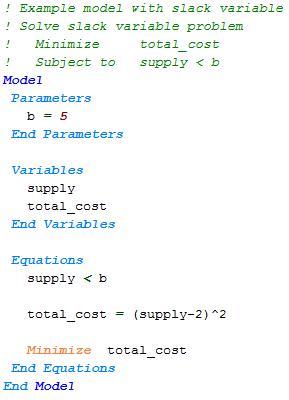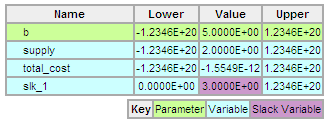Slack Variable Tutorial
Main.SlackVariables History
Show minor edits - Show changes to markup
or with the slack variable
or with the slack variable (s)
where s is the slack variable.
Slack variables are defined to transform an inequality expression into an equality expression with an added slack variable. The slack variable is defined by setting a lower bound of zero (≥0).
Slack variables are defined to transform an inequality expression into an equality expression with the added slack variable. The slack variable is defined by setting a lower bound of zero (≥0).
$$2x + y + s = 4$$
$$2x + y - 4 \ge 0$$
or with the slack variable
$$s = 2x + y - 4$$
Slack variables are defined to transform an inequality expression into an equality expression with an added slack variable. The slack variable is defined by setting a lower bound of zero (≥0).
Slack variables are defined to transform an inequality expression into an equality expression with an added slack variable. The slack variable is defined by setting a lower bound of zero (≥0).
slack > 0
slack ≥ 0
Slack variables are defined to transform an inequality expression into an equality expression with an added slack variable. The slack variable is defined by setting a lower bound of zero (>0).
Slack variables are defined to transform an inequality expression into an equality expression with an added slack variable. The slack variable is defined by setting a lower bound of zero (≥0).
Slack variables are additional variables used in optimization that convert an inequality constraint into an equality constraint, allowing the problem to be solved with standard methods, such as Interior Point Methods. Slack variables are typically denoted by the letter s and the value is always positive. Slack variables convert a constraint of the form "greater than or equal to" into an equation. For example, if the constraint is 2x + y ≥ 4, then the constraint can be rewritten as 2x + y + s = 4, where s is the slack variable.
Slack variables are additional variables used in optimization that convert an inequality constraint into an equality constraint, allowing the problem to be solved with standard methods, such as Interior Point Methods. Slack variables are typically denoted by the letter s and the value is always positive. Slack variables convert a constraint of the form "greater than or equal to" into an equation. For example, if the constraint is
$$2x + y \ge 4$$
then the constraint can be rewritten as
$$2x + y + s = 4$$
where s is the slack variable.
Slack variables are additional variables used in optimization that convert an inequality constraint into an equality constraint, allowing the problem to be solved with standard methods, such as Interior Point Methods. Slack variables are typically denoted by the letter s and the value is always positive. Slack variables convert a constraint of the form "greater than or equal to" into an equation. For example, if the constraint is 2x + y ≥ 4, then the constraint can be rewritten as 2x + y + s = 4, where s is the slack variable.
In Gekko Optimization Suite and the APMonitor Modeling Language, inequality constraints are automatically translated into equality constraints with slack variables. Slack variables can also be defined by starting a variable name with slk. When the model is parsed at run-time, any variable beginning with slk is automatically assigned a lower value of zero. Alternatively, inequality constraints will be automatically converted to equality constraints with a slack variable.
In Gekko Optimization Suite and the APMonitor Modeling Language, inequality constraints are automatically translated into equality constraints with slack variables. In APMonitor, slack variables can also be defined by starting a variable name with slk. When the model is parsed at run-time, any variable beginning with slk is automatically assigned a lower value of zero. Alternatively, inequality constraints are automatically converted to equality constraints with a slack variable.
Inequality Constraints in APM
In APMonitor Modeling Language, inequality constraints are automatically translated into equality constraints with slack variables. Slack variables can also be defined by starting a variable name with slk. When the model is parsed at run-time, any variable beginning with slk is automatically assigned a lower value of zero. Alternatively, inequality constraints will be automatically converted to equality constraints with a slack variable.
Inequality Constraints
In Gekko Optimization Suite and the APMonitor Modeling Language, inequality constraints are automatically translated into equality constraints with slack variables. Slack variables can also be defined by starting a variable name with slk. When the model is parsed at run-time, any variable beginning with slk is automatically assigned a lower value of zero. Alternatively, inequality constraints will be automatically converted to equality constraints with a slack variable.
$$\begin{align}\min \quad & cost_{total}\\\mathrm{subject to} \quad & supply<b\\& cost_{total}=(supply-2)^2\end{align}$$
$$\begin{align}\min \quad & cost_{total}\\\mathrm{subject\;to} \quad & supply<b\\& cost_{total}=(supply-2)^2\end{align}$$
$$\begin{align}\min & cost_{total}\\subject to & supply<b\\& cost_{total}=(supply-2)^2\end{align}$$
$$\begin{align}\min \quad & cost_{total}\\\mathrm{subject to} \quad & supply<b\\& cost_{total}=(supply-2)^2\end{align}$$
 Click to Solve a Slack Variable Optimization Problem
Click to Solve a Slack Variable Optimization Problem$$\begin{align}\min & cost_{total}\\subject to & supply<b\\& cost_{total}=(supply-2)^2\end{align}$$
(:source lang=python:)
- Solve slack variable problem
- Minimize total_cost
- Subject to supply < b
from gekko import GEKKO
b = 5 m = GEKKO(remote=False) supply = m.Var() total_cost = m.Var()
m.Equation(supply<b) m.Equation(total_cost==(supply-2)**2) m.Minimize(total_cost)
m.solve()
print(supply.value[0]) print(total_cost.value[0]) (:sourceend:)
 Click to Solve Slack Variable Optimization Problem Online
Click to Solve Slack Variable Optimization Problem Online(:title Slack Variable Tutorial:) (:keywords slack variables, inequality, slacks, lower bound, transform:) (:description Slack variables are used to transform an inequality expression into an equality expression:)
Slack Variables
Slack variables are defined to transform an inequality expression into an equality expression with an added slack variable. The slack variable is defined by setting a lower bound of zero (>0).
(:table border=1 width=100% align=left bgcolor=#FFFFFF cellspacing=0:) (:cellnr:) Inequality Constraint Form (:cell:) x > b (:cellnr:) Equality Constraint Form with Slack Variable (:cell:) x = b + slack (:html:)<br>(:htmlend:) slack > 0 (:tableend:)
(:html:) <iframe width="560" height="315" src="https://www.youtube.com/embed/jh6BK0BqqIs?rel=0" frameborder="0" allowfullscreen></iframe> (:htmlend:)
Example Problem
 Click to Solve a Slack Variable Optimization Problem
Click to Solve a Slack Variable Optimization Problem

Inequality Constraints in APM
In APMonitor Modeling Language, inequality constraints are automatically translated into equality constraints with slack variables. Slack variables can also be defined by starting a variable name with slk. When the model is parsed at run-time, any variable beginning with slk is automatically assigned a lower value of zero. Alternatively, inequality constraints will be automatically converted to equality constraints with a slack variable.
